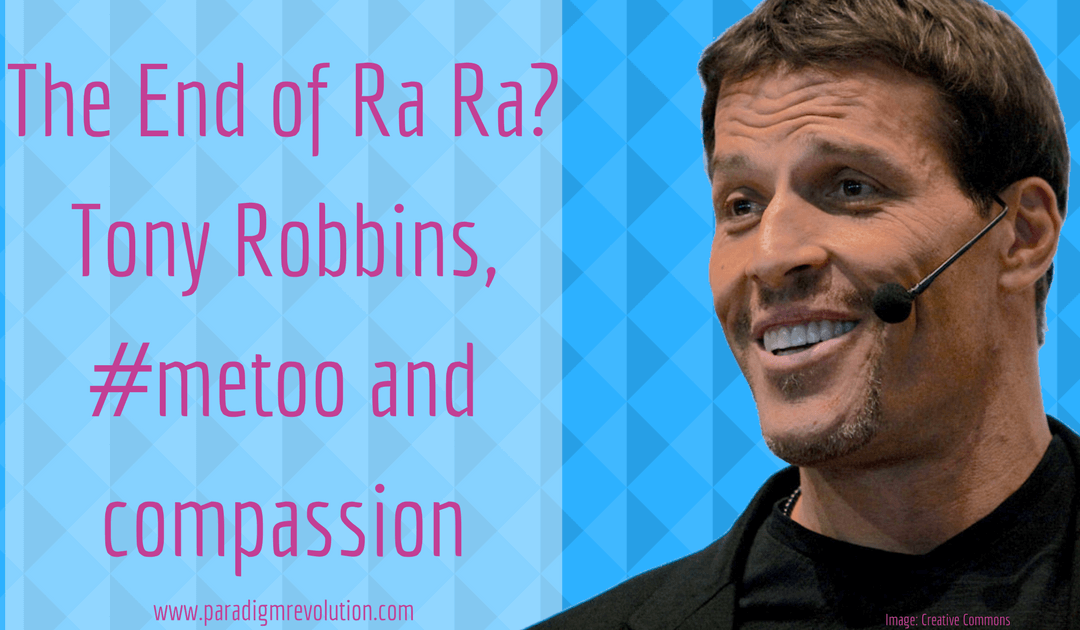
The End of Ra Ra? Tony Robbins, #metoo and compassion
A Viral Video
I’m writing at a time when Tony Robbins, the well-known personal development guru is being slammed all over the internet for disparaging the #MeToo movement. A video has gone viral which was taken at one of his events that shows a woman standing up to him on his views. So in this article, I will be examining Tony Robbins, #metoo and asking if this is a new opportunity for compassion.
We don’t know exactly what was said just before the video that started the whole discussion but the clip begins with audience member, Nanine McCool explaining to Robbins that he might have misunderstood what the #metoo movement was all about. Robbins quickly interrupts her and explains what he thinks the movement is all about – people holding onto victimhood and trying to gain significance.
Misunderstanding?
So far in the conversation, you can just about put a case that he hasn’t fully understood what the movement is about and that he is asking people to not hold on to the victimhood mentality as it doesn’t get them anywhere. He does state firmly that he believes some people are using this movement to attack people to gain “a drug called significance to make yourself feel good”.
At one point in the video, Robbins physically pushes McCool back several feet and tells her not to push back to demonstrate his point that pushing back never works. Perhaps he has used this exercise successfully before before but in this context the towering man over the much smaller woman being pushed by him came across as intimidating and in a way demonstrating what the #metoo movement is about: powerful men and women using their physicality to overpower and intimidate women and men who are not as strong as them.
Even so far, you may characterise him as simply misunderstanding everything.
Victim/ Perpetrator Confusion?
Yet if you look at what he says next, there is no doubt that he believes the #metoo movement is bad. He explains that he knows powerful men, dozens of them apparently, who are not hiring well-qualified women over their male, less-qualified counterparts because the women are so attractive that they are seen as too much of a risk.
Amazing! Apart from the fact that he is basically describing illegal, discriminatory practices, he is confirming so much of what women already suspect – that we are judged on our looks and perhaps other factors such as fertility over and above whether or not we can actually do the job.
It is this statement of Robbins that is particularly offensive. It might also suggest that he himself has perpetrated some acts that he may not feel so comfortable with speaking up about. In fact, earlier in the video he tries to get the room on board with him by getting people to raise their hand if they have done something that they feel guilty about. I am personally not aware of any accusations against Robbins of any kind so this is purely a speculation based on his behaviour in this clip.
The Nature of Victimhood

Image: Shutterstock
I have personally never been drawn to his brand of personal development and his courses of any sort, although I did read one of his books years ago. I do recognise that in general, he seems to help a lot of people.
But in this article, I wish to discuss the earlier statements in the viral video with Nanine McCool – that he recommends that we do not stay in victimhood because I think there are many opportunities here to understand how to be more compassionate with each other.
When saying that people, shouldn’t choose victimhood, Robbins is talking about people who are victims of sexual assault and harassment. The woman who stood up to him, McCool, actually made a video on Youtube in which she described how she was sexually abused as a child. In fact, she demonstrates how much she has not stayed in victimhood because she is strong enough to have stood up to him.
But even if she was dwelling on things, does Robbins really suggest that as a person who was molested as a child that she should have immediately brushed it off and moved on? And that nobody should push back against child molesters and rapists because it doesn’t make us any safer?
The Shadow Self of Tony Robbins?
In the backlash against him, he has come out with something interesting that may be the key to not only understanding his behaviour that day but his whole philosophy. He said that he too was also molested as a child.
I think this may be the key to why he behaved in this way. I suddenly see a man in so much pain that he himself cannot process his own emotions. I haven’t said this publicly but part of the reason why I wrote The Genius Groove is that I saw a video with Tony Robbins in which he described how you shouldn’t dwell on your emotions and rise above them. This is the exact opposite of what my message is all about.
Facing the shadow
I have found over the years that unless you face these emotions when you are ready and strong enough to do so, they can have powerful effects on your life. We are actually a fabric of consciousness. I think that below the speed of light this consciousness can have charge and polarity. These are emotions and they are not some extraneous nebulous thing – they are who we are and they make up our very vibration. We all know from the law of attraction and sympathetic vibratory physics that like vibrations attract, so these vibrations are attracting what our lives are made up of.
So if we work on our emotions and truly resolve buried issues, from a vibrational perspective this will change the very fabric of who we are. But if you take Robbins’ advice you are just plastering over the cracks. It may work for a while but after some time your buried emotions will resurface.
Elevation and avoidance
Putting all this together I think perhaps Robbins is working from a place of severe avoidance of his own pain. He is telling everyone not to go into victimhood because he cannot connect to his own victimhood. He has learnt a strategy of not dealing with his emotions but elevating himself and pushing himself harder rather than facing those shadow aspects.
In a way, this reflects his whole career – to make a different ‘choice’, rather than face the shadow. His whole teachings can be seen in a new light of pushing himself into an elevated state in order to escape the pain of his own abuse. That might be why he reacted so badly because facing the true victimisation of people who have been abused and are standing up and discussing it, would be like facing himself and that is too painful. So perhaps that is why he interrupted McCool so quickly.
An opportunity for compassion

Image: Pixabay
In any case, it is a lesson for all of us that we need to truly understand each other. If someone has indeed been the victim of sexual assault, they are indeed a victim (at the 3D level in any case). They have had something done to them which they have no control over. It is up to them how they heal and it is is going to be different for everyone. Nobody can tell them that they need to get out of victimhood if they need more time to heal.
And if, because of our current changing attitudes, that person is emboldened to speak out against the perpetrator who has, after all, committed a crime, then we should support them, not slam the victim. Robbins is actually making the people accused of the assault and even the ones interviewing people for jobs into the victims. The victims of beautiful women trying to get a job and of being caught out for what they have actually done. Don’t forget we are speaking about the perpetrators of crimes here – job discrimination and sexual assault. Yet the actual victims of the crimes he shows no sympathy for in this clip.
I am glad that this has come to light for many reasons. Maybe Robbins will now actually take the time to understand the #metoo movement and has indeed pledged this. He has also modelled for us some of the prevailing attitudes that some people brush incidents of sexual assault under the carpet and blame the victim when they try and stand up.
I suspect also, as I outlined earlier, that due to his own abuse when he was a child he is avoiding facing his shadow emotions about this. Perhaps this is compounded by feeling that, as a man, he is unable to face his emotions about his abuse as many other men also feel unable to do.
The End of Ra Ra?
I think the way to move forward is not to vilify Robbins but to maybe understand where he might be coming from – his own emotional landscape and drives and how he is mirroring certain attitudes in our society. We need to make it safer for men and women to come forward and face when they have been sexually abused otherwise, they may not just want to put a cap on their own emotions but shut up anybody else who might trigger them.

Image: Shutterstock
Exploring emotions are the key to moving forward. So maybe this is the death of the Ra Ra when it means elevating your mood and attitude as an act of denial of emotional shadow. Papering over the cracks of your emotions and pretending they don’t exist is not going to work because, like with Robbins, they will eventually rise up to the surface to be looked at just as his emotional shadow has now.
I know this is a controversial topic and I appreciate respectful comments below.
Images: Creative Commons, Shutterstock








